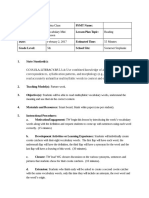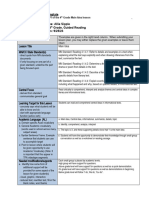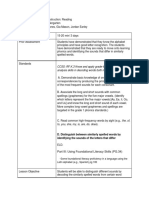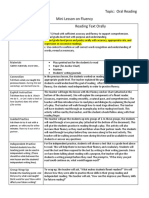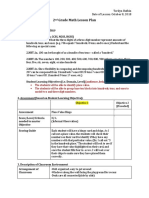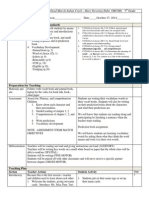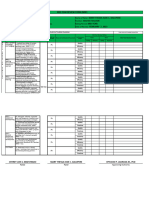Reading Comprehension Lesson Plan Final
Reading Comprehension Lesson Plan Final
Uploaded by
api-254917183Copyright:
Available Formats
Reading Comprehension Lesson Plan Final
Reading Comprehension Lesson Plan Final
Uploaded by
api-254917183Original Title
Copyright
Available Formats
Share this document
Did you find this document useful?
Is this content inappropriate?
Copyright:
Available Formats
Reading Comprehension Lesson Plan Final
Reading Comprehension Lesson Plan Final
Uploaded by
api-254917183Copyright:
Available Formats
Jennifer Thomas
Fifth Grade
Presentation Date: 2/11/2013 at 10:00 a.m.
Due for Review: 2/4/13
Page | 1
A. TITLE/ TYPE OF LESSON: Get the gist?/ Reading Comprehension
B. CONTEXT OF LESSON:
The students have been working on learning many different reading comprehension
strategies such as brainstorming, activating previous knowledge, predicting, inferring, K-W-L
charts, gist charts, summarizing, and much more. These are important skills they have been
developing for the Virginia SOL. They are important on the SOL because students will be asked
to read a short passage and answer many reading comprehension questions about the passage. If
the students do not understand it, they will not be able to answer these questions that test a vital
life skill. However these skills are life-long needed skills that students will continue to use over
and over as they advance in school. Although students may be able to read, one question still
exists. Do our students understand what they are reading? This question leads teachers to another
question. If our students do no understand something, what tools can we give them to help them
come to an understanding? One of the best ways to help children come to an understanding of
what they have read is teaching them ways to restate what they have read. Using a gist chart is
a way for students to find a starting point to writing a summary. If students can accurately
summarize a short story or something that they have read, it means that they can understand it. A
gist chart is a useful tool in writing a summary because it helps students focus on the important
aspects of who, what, when, where, why, and how of a story. A summary should include/cover
these things, which is what makes a gist chart a useful tool for students.
C. LEARNING OBJECTIVES:
Understand what are the broad
generalizations the students should
begin to develop? (These are
typically difficult to assess in one
lesson.)
Know what are the facts, rules,
specific data the students will gain
through this lesson? (These knows
must be assessed in your lesson.)
Do what are the specific thinking
behaviors students will be able to do
through this lesson? (These will also
be assessed in your lesson.)
1. Students will understand the
importance of summarizing.
1. Students will know what a
summary is.
1. Students will write an
accurate summary on a short
story.
2. Students will understand
what the gist of a story is.
2. Students will know how to
use a gist chart to figure out
the who, what, when, where,
why, and how of a story.
2. Students will complete a
gist chart to help them write
a summary on a short story.
3. Students will understand
how to use summarizing and
the gist of a story to explain
their comprehension of what
happened in the story.
3. Students will know how to
summarize and use a gist
chart to help them understand
the main point(s) of a story.
3. Students will use both a
gist chart and a written
summary to answer reading
comprehension questions
correctly.
Jennifer Thomas
Fifth Grade
Presentation Date: 2/11/2013 at 10:00 a.m.
Due for Review: 2/4/13
Page | 2
D. ASSESSING LEARNING
1. The students written summaries will be collected and read. This objective will be met
if students can accurately summarize the main point of the story.
2. The students gist charts will be collected and read. This objective will be met if
students accurately answer the who, what, when, where, and how of the gist chart.
3. The students questions will be collected and read. This objective will be met if
students correctly answered the reading comprehension questions that accompany the story
based off of what was written in their summary and gist chart.
E.RELATED VIRGINIA STANDARDS OF LEARNING
Demonstrate comprehension of fictional texts
5.5 The student will read and demonstrate comprehension of fictional texts, narrative,
Nonfiction and poetry.
b) Describe character development.
c) Describe the development of plot and explain the resolution of conflict(s).
e) Describe how an authors choice of vocabulary contributes to the authors style.
f) Identify and ask questions that clarify various points of view.
g) Identify main idea.
h) Summarize supporting details from text.
i) Draw conclusions and make inferences from text.
j) Identify cause and effect relationships.
k) Make, confirm, or revise predictions.
Demonstrate comprehension of nonfiction texts
5.6 The student will read and demonstrate comprehension of nonfiction texts.
a) Use text organizers, such as type, headings, and graphics, to predict and
categorize information in both print and digital texts.
c) Skim materials to develop a general overview of content and to locate specific
information.
d) Identify the main idea of nonfiction texts.
e) Summarize supporting details in nonfiction texts
f) Identify structural patterns found in nonfiction.
g) Locate information to support opinions, predictions, and conclusions.
h) Identify cause and effect relationships following transition words signaling the
pattern.
i) Differentiate between fact and opinion.
j) Identify, compare, and contrast relationships.
5.6 The student will read and demonstrate comprehension of nonfiction texts.
Jennifer Thomas
Fifth Grade
Presentation Date: 2/11/2013 at 10:00 a.m.
Due for Review: 2/4/13
Page | 3
b) Use prior knowledge and build additional background knowledge as context for
new learning.
k) Identify new information gained from reading.
l) Use reading strategies throughout the reading process to monitor comprehension.
m) Read with fluency and accuracy
F. MATERIALS NEEDED
- 24 copies of Crash Landing from Suviors High- Interest Nonfiction by Brenda Holt
McGee and Debbie Triska Keiser: My teacher
- 5 copies each of It Circulates, Indentured Servants, The Inner Planets, and
Whats in your Cells?: Me
- 24 copies of the gist chart: Me
- Overhead or document camera: My teacher
- White board/ white board markers: My teacher
G. PROCEDURE
Preparation of Learning Environment:
o Pass out the copies of Crash Landing, the other stories, and the gist chart
Engage- Introduction of Lesson Plan:
o Before beginning the actual lesson, I will ask students to tell me some of the
reading comprehension strategies that they have already learned.
o I will ask that student to explain the particular strategy that he/she presents.
o Lastly, I will ask them which strategies have worked the best in helping them to
understand a passage.
Implementation of Lesson:
o I will ask the students what they should do first before reading the story.
Read the title
Make predictions and inferences based on the title
Read the topic sentence of the first paragraph
Make more predictions
Read the topic sentence and closing sentence of each paragraph.
Ask yourself if anything sounds familiar. Are than any ideas that you
already know about? If so, what do you know about it?
Read the story
Assess your predictions. Did you predictions come true?
Fill out a gist chart
Summarize the story based off of the gist chart
o Ask students if they know what the gist of something means.
Jennifer Thomas
Fifth Grade
Presentation Date: 2/11/2013 at 10:00 a.m.
Due for Review: 2/4/13
Page | 4
Definition: main or essential point of something
o Allow for students to respond and take multiple responses
o Ask the students if they have ever heard of a gist chart
o Put the gist chart up on the document camera
o Go over each topic on the chart
Who is the story about? What is he/she doing? What is happening in the
story?
Why are the events happening? Why is he/she doing what he/she is doing?
When is he/she doing it?
Where is it taking place?
How is it taking place?
o Ask students why a gist chart might be helpful to understanding a story.
Allow many students to respond
o Read Crash Landing and fill in the gist chart for it. Ask the students for their
answers to each question of who, what, when, where, why, and how.
o After filling out the chart, ask students if they have ever heard of a summary.
If so, what do you know about it? Do you know what it is?
Definition: A brief statement or account of the main points of something
o Ask students how they could use the gist chart to write a summary.
A good summary addresses the who, what, when, where, why, and how of
a story.
What else should a summary have?
o Write a summary for Crash Landing
I will call on students to add a sentence to the summary one sentence at a
time.
o After the summary, answer the reading comprehension questions that go with the
story.
Closure:
o Discuss that they will be doing a gist chart and summary for the story It
Circulates.
They will fill out the gist chart first.
They will write a short summary based on their gist chart.
They will answer the reading comprehension questions for the story.
Clean- up:
o Have the students put everything away and clear their desks.
H. DIFFERENTIATION
1. Some students will need extra help, and there are teachers that push into the classroom
and provide extra help.
2. There are other students who have to push out of the classroom to other teachers that
provide one-on-one instruction.
Jennifer Thomas
Fifth Grade
Presentation Date: 2/11/2013 at 10:00 a.m.
Due for Review: 2/4/13
Page | 5
I.WHAT COULD GO WRONG WITH THIS LESSON PLAN AND WHAT WILL YOU DO
ABOUT IT?
1. Students could be bored during the lesson plan. If they seem bored, we will go through
the lesson quickly. Also, I can use Gladiator bucks that will encourage students to participate.
2. The students might not want to participate, and again, I will use Gladiator bucks to
encourage participation.
3. The document camera might not work. I will write the information on the board.
4. I might run out of time. If I begin to run out of time, I will briefly go over everything.
5. An emergency drill might occur. I will have the students follow the normal emergency
procedures, and we will pick up the lesson where it left off when the drill concludes.
Lesson Implementation Reflection
I. How did your actual teaching of the lesson differ from your plans? Describe the changes and
explain why you made them.
One of the biggest changes I made to my lesson was that I created a Prezi presentation for
the students to watch as I modeled what I wanted the students to do with the Crash Landing
story. I originally did not think about making aPrezi for this when I first developed my lesson
plan. Another change I made was that I did not print off the story for the first class. This did not
work well at all because I could not display the whole story at one time. I had to zoom into the
story so that the students could read it on the board. This meant that I had to wait until everyone
was done reading each section before I moved to the next section. This was not good because
some students do not read as well from the board, and some students read quicker than others.
Some students will also be distracted by other students once they are done. In order to fix this
problem, I printed out a copy of the story for each student during the second lesson. I should
have printed each student a copy from the beginning, but I was trying to save paper.
Another change that I had was that I showed the students my summary before talking to
the class about a good summary for the story. I originally planned to have the help me write a
summary, and then, they would compare the summary they helped me write to the one I wrote.
However, I accidently showed them the summary because I did not realize that was exactly
where I was. The second time I taught the lesson it went much better, and I had the students help
me write about a 5-6 sentence summary. They compared their summary to the one I wrote, and
they found that they were very similar but still a little different.
The first time I taught the lesson, my university supervisor came to observe. He sat right
up front, in front of all of the students. It made me extremely nervous, and my timing was thrown
off because of it. He interjected a few times with comments like Can you turn the lights off?
However, the students could read the story on the board once it was zoomed in. He also took
pictures while I was teaching, which again made me very uncomfortable. Another thing that I did
not plan for was him pulling me aside and talk to me in the middle of my lesson. Once I had
Jennifer Thomas
Fifth Grade
Presentation Date: 2/11/2013 at 10:00 a.m.
Due for Review: 2/4/13
Page | 6
finished my prezi presentation, he pulled me aside, which left my students a little confused
because they could not ask me questions. Some of the students needed a little clarification on the
assignment, and I could not answer their questions because my university supervisor had pulled
me aside. The second time I did this lesson, it went much better. I was able to answer the
students questions as soon as they got started, and they understood it much better than the first
group.
The second time I taught the lesson, it went much better. My timing was better, so the
students had a chance to finish everything I had asked. Also, I had them help me write a
summary before I showed them the summary I had already written. This made the students more
engaged because they were more involved in the presentation. I had also printed the story off for
the students, which made my presentation go much smoother. The students were able to refer
back to the story whenever they needed to in order to help create a summary, a gist chart, and
answer the questions. I was also much more comfortable teaching this lesson without my
university supervisor sitting right up front!
II. Based on the assessment you created, what can you conclude about your impact on student
learning? Did they learn? Who learned? What did they learn? What evidence can you offer
that your conclusions are valid?
1. The students written summaries will be collected and read. This objective will be
met if students can accurately summarize the main point of the story.
- I would say that this objective was met because 19 out of 20 (95%) students
successfully wrote a 5-6 sentence summary that allowed the reader to understand the
main point of the reading. I think that this objective was very successfully met.
2. The students gist charts will be collected and read. This objective will be met if
students accurately answer the who, what, when, where, and how of the gist chart.
- This objective was successfully met because 20 out of 20 students successfully
completed the gist chart. This means that 100% of the students understood the gist
chart and how to use it. It was also successful in helping students write their
summaries because 95% of the students wrote a good summary.
3. The students questions will be collected and read. This objective will be met if
students correctly answered the reading comprehension questions that accompany the
story based off of what was written in their summary and gist chart.
- This objective was not successfully met because only 11 out of 20 students
successfully answered their questions. This means that only 55% of the students
successfully answered at least 4 out of 5 questions correctly. One reason that this
might have happened is that they did not finish the questions. Another reason the
students might have done poorly on the reading comprehension questions is that
they might not have understood the questions. A third reason that they might have
Jennifer Thomas
Fifth Grade
Presentation Date: 2/11/2013 at 10:00 a.m.
Due for Review: 2/4/13
Page | 7
done poorly on the questions is that they might have rushed through them. I feel
like it could be anyone of these reasons or more likely a combination of them.
-I feel like I was able to successfully help students learn a new method to enhance their level of
comprehension because the students were able to fill out the gist charts and write good
summaries. However, I believe that the students need more strategies to help them successfully
answer the questions about the readings. The students learned how to write good summaries on a
reading based on the gist chart they filled out. This is important because on the Virginia SOL,
there will be questions that will present 4 possible summaries of a passage the student will have
read. Based on the choices, the students will have to pick the best summary. The more practice
the students have writing clear and concise summaries, the better they will be at picking out the
correct answer on tests like the SOLs. My conclusions are valid based on my assessments that I
created. The students were successful at filling out a gist chart and writing a good summary.
There were 19 out of 20 students who filled out the gist chart correctly, and all 20 out of 20
students wrote a good, clear, concise summary. Based on my assessment data, the students were
successful in learning how to write good summaries, but if I were the classroom teacher, I would
focus on different strategies on answering reading comprehension questions next.
III. Describe at least one way you could incorporate developmentally appropriate practice in a
better or more thorough way if you were to teach this lesson again.
One way that I could incorporate developmentally appropriate practice is to have students
do as much practice as possible. One activity that I could do is work on reading a novel or book,
and I would pick a book that does not have too many chapters but is still interesting. The
students can read chapter by chapter, and after each chapter, the students can write their own
summary. The students can have different partner for each chapter. After each summary, the
students partner will read the summary and decide if it accurately summarizes the chapter. The
students will go chapter by chapter and continuously give each other feedback. By the end of the
book, the students will read their summary of the first chapter and their summary of their last
chapter. They will compare them so that they can see their progress from the beginning until the
end. This will help them develop and lay the foundations to quickly think in their heads what a
short/brief reading is about. This will help them figure out the main idea or concept in a
particular reading that they do. This practice will help them with developing a deeper and better
comprehension of what they read. When they are able to create a good summary, they will be
better at answering reading comprehension questions because the students are applying and
analyzing what they read in the reading, which will help them with the lower level of
comprehending.
IV. Based on the assessment data you collected what would you do/teach next if you were the
classroom teacher?
If I were the classroom teacher, I would go over extra reading strategies to help students
answer reading comprehension questions. Writing a short and quick summary helps the students
review the information again and quickly look back through the reading. If someone can
Jennifer Thomas
Fifth Grade
Presentation Date: 2/11/2013 at 10:00 a.m.
Due for Review: 2/4/13
Page | 8
summarize something that he/she has read, then it is a good indicator that he/she understood and
comprehended what he/she read. However, it is not the only strategy to help with reading
comprehension. There was only one student who did not write an accurate summary of what
he/she had read. However, only 55% of 20 students answered all 5 questions correctly. Based on
this data I would review different strategies to developing an answer to reading comprehension
questions. One method I would go over is proving your answer. I would have the students read
the entire reading first. Then, the student will look at each question one by one. The student will
read the question, and find the answer in the reading. The student will either highlight or
underline the answer to the question. The student will write above the sentence which question
number that it answers. For opinion questions, the students will find a sentence in the reading
that helped them to come to an opinion on what the question is asking him/her about. Another
thing that students can use is a graphic organizer to help them organize the information they read
in the story. One thing they can use is a Venn diagram or a story map. There are many different
types of reading strategies that young students can use to help develop a deeper comprehension
of what is read, but based on my assessment information, I would practice answering different
types of reading comprehension questions because the students did not meet the criteria for my
third assessment.
V. As a result of planning and teaching this lesson, what have you learned or had reinforced
about young children as learners?
One thing that I learned about young learners is that they are more engaged in my prezi.
The topic I was discussing can be a very boring thing, but my students were very engaged in the
lesson because of the motion and graphics of the prezi. They were really excited about it, and
they kept asking me questions. They wanted to get through it to see what would happen next.
The prezi really helped capture and keep their attention. I was really glad I changed my lesson to
a prezi because I think it went better then it would have without using the prezi. I did not realize
the students would like it as much as they did, but I was pleasantly surprised. From now on, I
will use a prezi for a lot of different lessons.
One thing that was reinforced about young children was that they like to work in groups.
Many of the students really benefited from being able to work in groups of 5. It helped a lot of
the students because they were able to read the passage together and ask each other questions. It
also made them feel more comfortable asking me a question about something the entire group
did not understand as opposed to one person feeling intimidated to ask a question about
something he/she does not understand. I like to put students in groups as much as possible so that
they can bounce ideas off of each other because I feel like they enjoy it more and learn more
together than alone.
VI. As a result of planning and teaching this lesson, what have you learned or had reinforced
about teaching?
Jennifer Thomas
Fifth Grade
Presentation Date: 2/11/2013 at 10:00 a.m.
Due for Review: 2/4/13
Page | 9
One thing that I learned about teaching is that it is very helpful to make boring topics
interesting with adding graphics like the prezi. It really engaged the students. Another thing that
pulled the students attention in was asking for their help to write a summary. The students
enjoyed being in charge of what I was writing on the board. Another thing that I learned is that it
can be very difficult to make boring topics interesting. I had to work really hard to come up with
a way to make my presentation interesting. Prezi is one resource that I will keep in the back of
my mind to help make things more creative and interesting. I struggled to come up with
something more fun and interesting, and I was very excited once I made the prezi.
VII. As a result of planning and teaching this lesson, what have you learned or had reinforced
about yourself?
One thing that I learned about myself is that I really get into a lesson when the students
are really enjoying what I am teaching them. It made me really happy to see them enjoy the prezi
presentation. Knowing that reading comprehension is not always the most fun subject, I was
worried they would be extremely bored and unresponsive. However, I think the prezi helped the
students really be engaged in what I was talking about. I work really hard to come up with ideas
that I think the students will like, and I get really excited to see them excited about learning.
Another thing that I learned about myself is that I need to relax. I know that there will be people
that will come through like the principal or other administrators who are going to observe me. I
need to feel more comfortable with other people observing me. I think I was extra nervous
because my university supervisor was front and center in observing me. The last thing that I
learned about myself is that I still need as much practice as possible. Like I said before, my
second lesson went much better than the first lesson. This is because I was able to work out all
the glitches that happened the first time I taught it. I was more on track with time, and the
students in my second lesson were able to finish the activity that I had given them. I also learned
that a good lesson takes a lot of work and development, and I worked hard to create this lesson. I
was excited to see the students really enjoy the lesson.
You might also like
- Module 1 - Diagnostic Test & OrientationDocument44 pagesModule 1 - Diagnostic Test & OrientationCzarina Cleth Macuha88% (8)
- Student Teaching Edtpa Lesson Plan TemplateDocument3 pagesStudent Teaching Edtpa Lesson Plan Templateapi-353040687No ratings yet
- Portfolio AssessmentDocument49 pagesPortfolio AssessmentJasmin Daro50% (2)
- Content Area Lesson PlanDocument10 pagesContent Area Lesson Planapi-583719242No ratings yet
- Comprehension Lesson PlanDocument12 pagesComprehension Lesson Planapi-464778396No ratings yet
- Writing Lesson PlanDocument39 pagesWriting Lesson Planapi-482714429No ratings yet
- Assignment 3 - 3 Lesson PlansDocument6 pagesAssignment 3 - 3 Lesson Plansapi-238349234No ratings yet
- Lesson Plan vs4c and DDocument2 pagesLesson Plan vs4c and Dapi-254917183No ratings yet
- HL Unit Planner MYP1 Chinese Theatre Masks 2012Document2 pagesHL Unit Planner MYP1 Chinese Theatre Masks 2012avalanchequeenNo ratings yet
- HSSCI Principles of CommerceDocument40 pagesHSSCI Principles of Commercehamidalikhanscorpion100% (1)
- Comprehension Lesson Plan Marisol TerronesDocument2 pagesComprehension Lesson Plan Marisol Terronesapi-311942428No ratings yet
- Vocabulary Mini Lesson PDFDocument2 pagesVocabulary Mini Lesson PDFReina ClausNo ratings yet
- Independent Lesson Plan - Jada GriggsDocument4 pagesIndependent Lesson Plan - Jada Griggsapi-345771743No ratings yet
- Lesson Plan Form - 6th GradeDocument3 pagesLesson Plan Form - 6th GradeBrigitte NoveloNo ratings yet
- Language Arts Lesson PlanDocument2 pagesLanguage Arts Lesson Planapi-354210676No ratings yet
- Learning Segment-Ela 3Document10 pagesLearning Segment-Ela 3api-254944388No ratings yet
- Depaul University Elementary Lesson Plan Format: Rationale of The Lesson Design/Prior Learning/Learning SegmentDocument11 pagesDepaul University Elementary Lesson Plan Format: Rationale of The Lesson Design/Prior Learning/Learning Segmentapi-514518399100% (1)
- ELD Levels/can Do Descriptors, Etc.) : This Lesson Is Intended For Use in A 9th Grade ELADocument18 pagesELD Levels/can Do Descriptors, Etc.) : This Lesson Is Intended For Use in A 9th Grade ELADanahNo ratings yet
- Edtpa Lesson PlansDocument12 pagesEdtpa Lesson Plansapi-34049548767% (3)
- Lesson PlanDocument8 pagesLesson Planapi-440401318No ratings yet
- Learning Segment-Ela 2Document10 pagesLearning Segment-Ela 2api-254944388No ratings yet
- Ugly Duckling. First GradeDocument6 pagesUgly Duckling. First GradeMaguie SarmientoNo ratings yet
- Nouns and VerbsDocument3 pagesNouns and Verbsapi-270317081No ratings yet
- Pre-Planning: CC.1.1.1.D: Know and Apply Grade Level Phonics and WordDocument8 pagesPre-Planning: CC.1.1.1.D: Know and Apply Grade Level Phonics and Wordapi-280008473100% (1)
- Lesson Plan Template and Rubric: Central FocusDocument10 pagesLesson Plan Template and Rubric: Central FocusIryna DribkoNo ratings yet
- Mini Lesson Plan 7Document3 pagesMini Lesson Plan 7api-260889954100% (2)
- Lesson Plan-Story Elements-Yasmeen RDocument2 pagesLesson Plan-Story Elements-Yasmeen Rapi-508750657No ratings yet
- Central Focus/: Teacher CandidateDocument7 pagesCentral Focus/: Teacher CandidateCaleighNo ratings yet
- Edtpa Main Idea Lesson Plan 1Document13 pagesEdtpa Main Idea Lesson Plan 1api-708704290No ratings yet
- Lesson PlanDocument2 pagesLesson Planapi-314521282No ratings yet
- Lesson 1 - Story StructureDocument4 pagesLesson 1 - Story StructureAnonymous Z9zcD6BzNo ratings yet
- Read Aloud Lesson PlanDocument6 pagesRead Aloud Lesson Planapi-349922174No ratings yet
- First Grade Persuasive Writing UnitDocument8 pagesFirst Grade Persuasive Writing UnitKat2234No ratings yet
- ThingDocument45 pagesThingEric ShauNo ratings yet
- Supervisor Ela Lesson PlanDocument8 pagesSupervisor Ela Lesson Planapi-477345968No ratings yet
- Phonemic Awareness Lesson PlanDocument2 pagesPhonemic Awareness Lesson Planapi-252652918No ratings yet
- Read 3226 Whole Class Lesson Plan - Main Idea and Key DetailsDocument6 pagesRead 3226 Whole Class Lesson Plan - Main Idea and Key Detailsapi-217043801No ratings yet
- 400 Lesson PlanDocument4 pages400 Lesson Planapi-403104065100% (1)
- Immigration Letters RubricDocument2 pagesImmigration Letters Rubricapi-288669283100% (1)
- Lesson Plan Ted 508Document4 pagesLesson Plan Ted 508api-486161267100% (1)
- Writing Lesson Plan April 26thDocument3 pagesWriting Lesson Plan April 26thapi-3566001480% (1)
- Prefixes Lesson ExampleDocument4 pagesPrefixes Lesson Exampleapi-270541136No ratings yet
- Metaphor Lesson Plan 4th GradeDocument5 pagesMetaphor Lesson Plan 4th Gradeapi-241345614No ratings yet
- Fluency Mini LessonDocument2 pagesFluency Mini Lessonapi-437527252100% (1)
- Anglophone School District - North: Grade 5 Science - Unit Lesson Guide Properties and Changes in MaterialsDocument51 pagesAnglophone School District - North: Grade 5 Science - Unit Lesson Guide Properties and Changes in MaterialsZuyin AeneahNo ratings yet
- Opinion Writing Lesson 4Document6 pagesOpinion Writing Lesson 4api-599252831No ratings yet
- Reading Group Lesson PlanDocument7 pagesReading Group Lesson PlanBreanna FuehrerNo ratings yet
- Direct Instruction History Lesson PlanDocument10 pagesDirect Instruction History Lesson Planapi-300194441No ratings yet
- ComprehensionDocument6 pagesComprehensionapi-324729346No ratings yet
- Poetry UnitDocument15 pagesPoetry Unitapi-531843492No ratings yet
- Social Studies Lesson PlanDocument7 pagesSocial Studies Lesson Planapi-404999113No ratings yet
- Mathematics Lesson Plan For 1st GradeDocument5 pagesMathematics Lesson Plan For 1st Gradeapi-302422262No ratings yet
- Phonics 11 PT Lesson PlanDocument2 pagesPhonics 11 PT Lesson Planapi-342249489No ratings yet
- Analytical PhonicsDocument6 pagesAnalytical PhonicsI-Reen FrancisquiteNo ratings yet
- 2nd Grade Math Lesson Plan 3-Digits PDFDocument7 pages2nd Grade Math Lesson Plan 3-Digits PDFapi-430893986No ratings yet
- Learning Segement - Ela 1Document10 pagesLearning Segement - Ela 1api-254944388No ratings yet
- Direct Instruction Lesson Plan Template: Ccss - Ela-Literacy.L.1.4.BDocument3 pagesDirect Instruction Lesson Plan Template: Ccss - Ela-Literacy.L.1.4.Bapi-405196113No ratings yet
- Once Upon A Time Unit Plan Shortened UpdatedDocument8 pagesOnce Upon A Time Unit Plan Shortened Updatedapi-528613139No ratings yet
- 5thgr Lesson Plan Day 1-2Document3 pages5thgr Lesson Plan Day 1-2api-24181950550% (2)
- Sample Lesson PlanDocument6 pagesSample Lesson PlantmanareNo ratings yet
- Mapping the Way from Teacher Preparation to edTPA® Completion: A Guide for Secondary Education CandidatesFrom EverandMapping the Way from Teacher Preparation to edTPA® Completion: A Guide for Secondary Education CandidatesNo ratings yet
- From Research to I-Search: Creating Lifelong Learners for the 21st CenturyFrom EverandFrom Research to I-Search: Creating Lifelong Learners for the 21st CenturyNo ratings yet
- Jenniferthomas Recommendation1Document1 pageJenniferthomas Recommendation1api-254917183No ratings yet
- Lesson Plan 4eDocument2 pagesLesson Plan 4eapi-254917183100% (2)
- Integrated Science Education Weather UnitDocument25 pagesIntegrated Science Education Weather Unitapi-254917183No ratings yet
- Number Combinations and ST LP March 26Document1 pageNumber Combinations and ST LP March 26api-254917183No ratings yet
- Pattern LP April 1Document1 pagePattern LP April 1api-254917183No ratings yet
- Student Strength and WeaknessDocument3 pagesStudent Strength and Weaknessapi-254917183No ratings yet
- Math Tessellation Lesson PlaDocument9 pagesMath Tessellation Lesson Plaapi-254917183No ratings yet
- Unit Lesson Plan On ReconstructionDocument45 pagesUnit Lesson Plan On Reconstructionapi-254917183No ratings yet
- Lesson Plan Growing PatternsDocument9 pagesLesson Plan Growing Patternsapi-254917183No ratings yet
- Stage 2Document5 pagesStage 2api-254917183No ratings yet
- Learning MenuDocument6 pagesLearning Menuapi-254917183No ratings yet
- Ubd Unit Plan 1Document15 pagesUbd Unit Plan 1api-254917183No ratings yet
- Area and Perimeter Creative Arts LessonDocument9 pagesArea and Perimeter Creative Arts Lessonapi-254917183No ratings yet
- Personal Data Form SelnajayaDocument5 pagesPersonal Data Form SelnajayaAbu AttaQi100% (1)
- Personal Development, Health and Physical EducationDocument97 pagesPersonal Development, Health and Physical EducationClaudiuNo ratings yet
- Learning Activity Sheet: QUARTER 1/first SemesterDocument14 pagesLearning Activity Sheet: QUARTER 1/first SemesterKhylie VaklaNo ratings yet
- Criterion 4. Continuous ImprovementDocument8 pagesCriterion 4. Continuous Improvementmagdy bakryNo ratings yet
- Expectation 5Document3 pagesExpectation 5api-289162459No ratings yet
- Amcgmp 147Document68 pagesAmcgmp 147DJSohunNo ratings yet
- Self-Reflection of Teacher Work Sample-2Document2 pagesSelf-Reflection of Teacher Work Sample-2api-534417134No ratings yet
- Samples of Analytic RubricsDocument8 pagesSamples of Analytic RubricsEzikawa KirtNo ratings yet
- MRF 2023Document2 pagesMRF 2023Jeffrey Lois Sereño MaestradoNo ratings yet
- LP 3 EED3 Edited PDFDocument19 pagesLP 3 EED3 Edited PDFAlthea GatilNo ratings yet
- Educ - 104 Course SyllabusDocument10 pagesEduc - 104 Course SyllabusjayrasuizosumileNo ratings yet
- Effective Teaching - Chapt 1Document9 pagesEffective Teaching - Chapt 1hyrakgNo ratings yet
- BeresfordEL106Prep and Teaching of Literature ModulesDocument64 pagesBeresfordEL106Prep and Teaching of Literature ModulesMichael Nivero ManaladNo ratings yet
- Foundations of Special and Inclusive Education - Semi Final NotesDocument18 pagesFoundations of Special and Inclusive Education - Semi Final Noteskilatmarielleann.cte.cpcNo ratings yet
- Technology Plan and Infrastruture Support SystemDocument8 pagesTechnology Plan and Infrastruture Support SystemRodrick Sonajo RamosNo ratings yet
- Model SAR PDFDocument81 pagesModel SAR PDFhcmes KadapaNo ratings yet
- Ten Thank You Letters Observation TwoDocument4 pagesTen Thank You Letters Observation Twoapi-479420774No ratings yet
- Lesson Plan 2 - Uses of Natural ResourcesDocument4 pagesLesson Plan 2 - Uses of Natural Resourcesapi-349867855100% (3)
- LP 19 JuneDocument2 pagesLP 19 JuneIlham IzzatNo ratings yet
- Instructional Competencies of Technology and Livelihood Education (TLE) Teachers: Basis For A Competency-Based ModuleDocument13 pagesInstructional Competencies of Technology and Livelihood Education (TLE) Teachers: Basis For A Competency-Based ModulecanobasrhonaliediosoNo ratings yet
- Problems Involving Circumference of Circles Lesson PlanDocument1 pageProblems Involving Circumference of Circles Lesson PlanJonathan RobinsonNo ratings yet
- Elm-490 Step Standard 7 2Document16 pagesElm-490 Step Standard 7 2api-458840883No ratings yet
- Null 4Document8 pagesNull 4Mugara Waitega PeterNo ratings yet
- EDU431 - Solved GDBDocument2 pagesEDU431 - Solved GDBa.ali9589541No ratings yet
- Music Practice MethodsDocument37 pagesMusic Practice MethodsVii Cabanillas PNo ratings yet
- Behavior Intervention PlanDocument21 pagesBehavior Intervention Planapi-271896767No ratings yet











